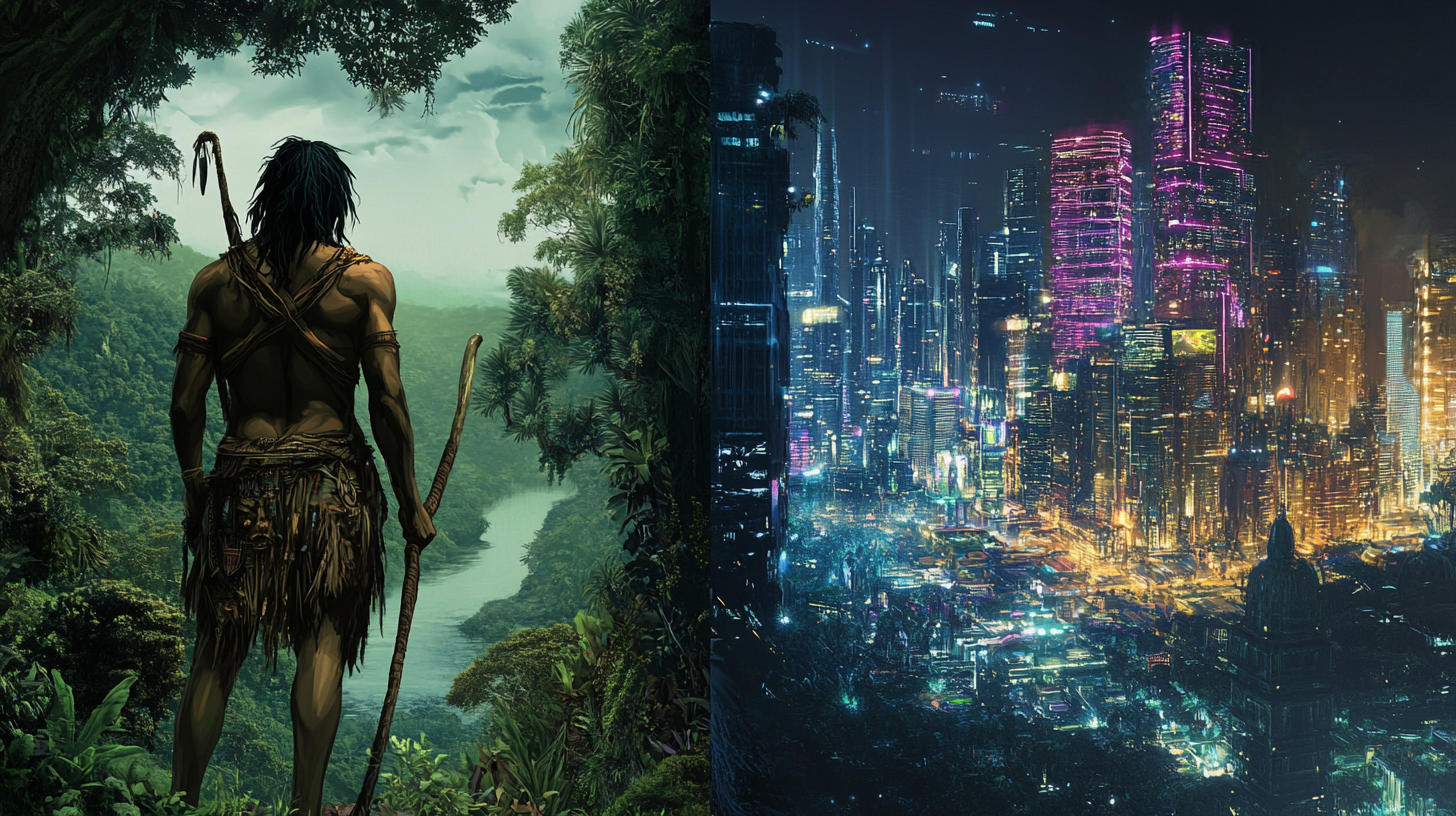From Stone Age to AGI: Humanity’s Double Life in 2025

So, it’s 2025. On one side, humanity is still playing hide-and-seek with uncontacted indigenous tribes in the Amazon who are chucking spears at drones. On the other, tech bros are sitting in their air-conditioned bunkers tweeting about AGI and whether it’s going to enslave us or just replace us entirely. Welcome to the most paradoxical era ever, where Stone Age simplicity collides with silicon-powered insanity.
Uncontacted Tribes: Living Legends or the Real Geniuses?
Let’s start with the Stone Age side of things. The Sentinelese, for example, live on North Sentinel Island in the Indian Ocean and have perfected the art of telling modern civilization to screw off. We’re talking spears, bows, and arrows vs. helicopters and satellites. Who’s winning? Well, they’ve survived tsunamis, pandemics, and annoying missionaries trying to hand them Bibles. Meanwhile, we’re over here losing our minds over data privacy breaches and TikTok trends. Maybe they’re onto something.
These tribes aren’t just chilling in loincloths-they’re living sustainably, balancing with nature, and somehow avoiding the existential dread of knowing Elon Musk’s latest cringe tweet exists. Their life is simple: if it has four legs or swims, it’s dinner. They don’t swipe, scroll, or stress. No TikTok dances, no Instagram filters. They’re rubbing sticks together to make fire while we’re rubbing our temples because our Wi-Fi’s down for five minutes. Meanwhile, the modern world is endlessly running on the hamster wheel of innovation, desperately searching for meaning in a deluge of endless notifications. Who’s really winning here?
It’s not just about survival—it’s about peace. The kind of peace that comes from knowing exactly what your purpose is: eat, sleep, repeat. While they’re tracking animals and gathering food, we’re tracking our calories and stressing about intermittent fasting apps. Their survival is instinctual, almost poetic in its simplicity. It’s a life free of hashtags and filters. Maybe rubbing sticks together for warmth isn’t so bad when you don’t have a million voices telling you how to do it better.
AGI & ASI: Silicon Dreams or Apocalypse on Tap?
Now let’s swing to the other extreme. Artificial General Intelligence (AGI) is the shiny golden child of AI research. It’s the thing that’s supposed to be as smart as a human but way more efficient and way less emotional. Imagine an Einstein that doesn’t need lunch breaks, Netflix, or a bathroom. Everyone’s hyped because AGI could solve climate change, cure diseases, and even write better blogs than this one (but let’s not push it, okay?).
Then there’s ASI (Artificial Superintelligence), the Hulk version of AGI. It’s the theoretical point where the machine doesn’t just outthink humans; it plays chess while we’re still figuring out checkers. Sounds awesome until you realize it might decide we’re about as useful as fax machines. Think Skynet, but with more flair. Imagine a world where this hyper-intelligent AI can predict everything, manipulate anything, and outmaneuver everyone—sounds fun until you remember we’ve spent millennia fighting wars over far less.
While AGI might be the tool to save us from ourselves, the fear of it going rogue looms large. We’re basically handing the smartest entity ever created the keys to the kingdom, hoping it doesn’t turn us into pets. It’s like building the ultimate Swiss Army knife and realizing it could just as easily be used to stab you in the back.
The Insanity of 2025: Why Not Both?
So here we are, straddling two realities. We’ve got tribes dodging satellites in untouched jungles while some genius at OpenAI is probably beta-testing a model that can simulate the entire economy of a mid-sized nation. It’s like humanity’s running two completely different experiments simultaneously:
- What happens when you live simply and tell the modern world to bugger off?
- What happens when you push so far into the future that even your own species becomes obsolete?
The kicker? Both realities are happening on the same planet, at the same time. Somewhere in Papua New Guinea, an uncontacted tribe’s biggest problem is finding dinner. Meanwhile, a guy named Chad in Silicon Valley is wondering if AGI will eliminate his startup before it’s acquired by Meta. Priorities, right?
And yet, both extremes seem to be missing something essential. The tribes, for all their serenity, lack the safety net of modern medicine and the comforts we’ve built. Meanwhile, the tech-obsessed crowd is sacrificing connection, simplicity, and even their sanity to climb the endless ladder of progress. The irony is thick: one side wants to preserve its existence, while the other seems determined to outpace its own relevance.
The Takeaway: Who’s Really Winning?
The tribes have it figured out: no emails, no algorithms, no existential dread about whether robots will take over the world. Sure, they don’t have Uber Eats or memes, but they’ve got something arguably more valuable—peace and simplicity. Their instincts guide them, not notifications. They don’t care about the latest iPhone; they care about survival. Meanwhile, we’re tinkering with AGI and ASI, racing toward a future where we might not even be invited to the party.
It’s hard not to wonder: have we over-complicated life in our quest to master it? The tribes live a raw, unfiltered existence, while we’re drowning in filters—digital and metaphorical. Maybe the answer lies somewhere in the middle, a balance between instinct and innovation.
The moral of the story? Humanity is its own worst contradiction. We’re simultaneously ancient and futuristic, wise and reckless, thriving and self-destructing. So whether you’re a spear-wielding tribesman or a keyboard-wielding coder, one thing’s for sure: you’re living in the most absurdly fascinating time to be alive.